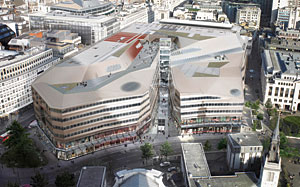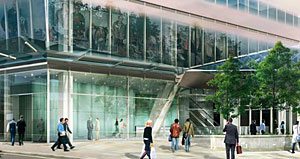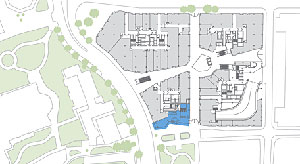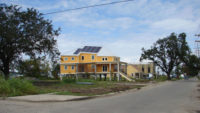


Work is progressing on Jean Nouvel’s One New Change in central London.
While construction launches have come to a virtual halt in central London, highly visible projects that predate the economic downturn are coming to fruition. A trio of wind turbines that will crown the 43-story Castle House designed by London-based architecture firm Hamiltons are being fabricated in Sweden. The tropical-colored ceramic skins of the Renzo Piano–designed Central Saint Giles have begun wowing tourists strolling among the theaters of Soho and Covent Garden. And on October 14, One New Change will top out.
French architect Jean Nouvel’s competition-winning design for One New Change was first shown in 2005. The building, which combines approximately 220,000 square feet of retail space with 350,000 square feet of offices, still must have its glazing and interior fitout completed and should open this time next year. The developer is Land Securities, which recently delayed start on a Rafael Viñoly skyscraper on Fenchurch Street.
Unlike Viñoly’s “walkie-talkie” or Castle House, One New Change is considerably shorter than its peers. “Nouvel has referred to it as a Stealth Bomber,” says Land Securities development manager Kathrin Hersel, referring to the building’s low and subtly faceted profile.
Limiting height responds to planning restrictions barring interference with the sight lines surrounding St. Paul’s Cathedral. So, too, does One New Change’s curtain wall, whose fritted glass—featuring varying shades of red, gray, and beige to evoke neighboring facades—diminishes the reflectivity that local authorities feared would distract from Sir Christopher Wren’s masterpiece.
In further homage, the building volume splits around its east-west axis, creating an outdoor courtyard that looks to the cathedral, as do minimally fritted “clouds” in the glass portions of the roof. A north-south route through the mall resurrects a medieval street, and on top of the unglazed parts of the roof, visitors to public gardens can look into St. Paul’s famous Whispering Gallery.
Although Prince Charles unsuccessfully tried preventing Nouvel’s scheme from realization—unlike his campaign against Richard Rogers’s Chelsea Barracks—the public feels more positively about One New Change. Peter Murray, chairman of New London Architecture, notes that the glazing may appear more conventional than computer renderings initially promised, but that the material palette “clearly is in contrast to the Portland stone of St. Paul’s…as it should be.” Murray also forecasts, “It will be seen as a very polite building that delivers a real treat—a previously unavailable view of the apse and the dome.”
Neil Paterson, a head of project management for Land Securities, says the participation of a renowned architect like Nouvel expedited the planning-approval process. He adds, “There’s a theoretical uplift in value with a bespoke world-class building.” Leases have been signed for 35 percent of the shopping mall, and for one-third of One New Change’s available office space.




Post a comment to this article
Report Abusive Comment